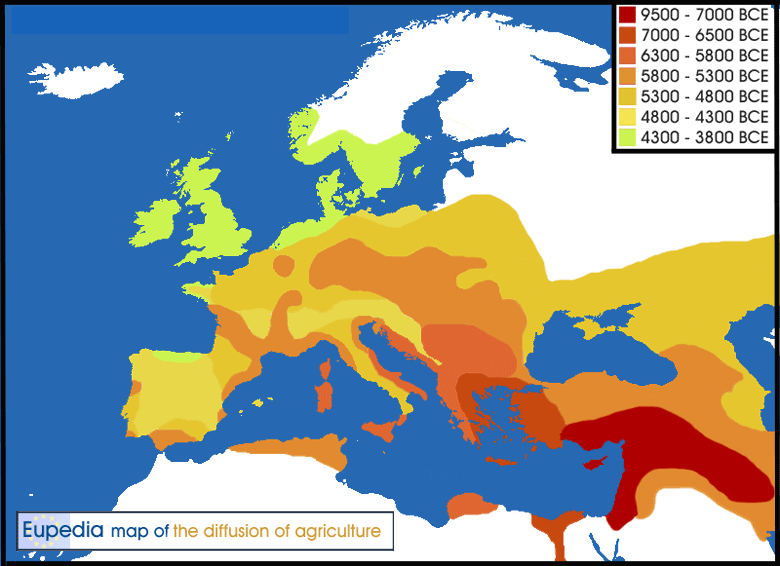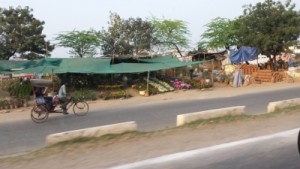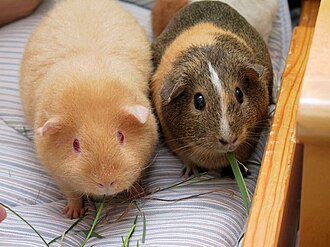
Here’s the next in the Basic Elements series – this time looking at food. Life needs food – human life just as much as any other kind of life. And for a great deal of humanity’s existence, finding an adequate supply of food has dominated communal needs. Douglas Adams, with his usual flair for insight, wrote of the three phases of every major Galactic civilisation, characterised by the questions “how can we eat?“, “why do we eat?“, and finally, “where shall we have lunch?“. Many readers will probably think of themselves in the third phase, but it’s worth remembering that a huge number of people on Earth are still struggling at phase one.
After the glaciers of the last ice age retreated, about 12,000 years ago, hunter-gatherer groups followed the milder weather back north, resettling tracts of land which had been their distant ancestors’ homes long before. They followed not just the warmth, but also the herds and flocks as they migrated, and the seasonal yield of trees and bushes. Small migrant groups could eat off the land tolerably well, so long as they were willing to keep on the move, and retained a good pragmatic understanding of seasonal changes. They were self-sufficient.

Then farming came along, spreading across Europe from south east to north west. Farming communities have to stay put, not just season to season but also year to year. Fixed territory, and its ongoing fertility, become crucial. Our remote ancestors must have seen a clear advantage in this way of life, partly no doubt because it could support much greater populations, but it also brought risk. A bad year can signal disaster – and it is no longer possible just to follow the herds elsewhere. Your communal wealth can no longer easily be moved, and a good parcel of land somewhere nearby has probably already been settled. Either you stay put, and try to wait out the famine, or you go to war.

But another corollary of settled communities is that they typically have a surplus of some things – and a surplus can be traded for whatever you lack. So you hedge, accepting that you cannot grow or produce some goods, and relying on your neighbours who can. You grow less dependent on your immediate fields to give everything you need, but more dependent on the resources of a wider area.
The historical fiction I write is set in a place and time where the dependence on other places has not become too firmly fixed. Kephrath and her sister towns certainly make use of trade links, but for bulk supplies are largely self-sufficient. Four towns together, and their hinterland, can manage.
The process of increasing specialisation of any one place, and increasing dependence on an ever larger area, has continued largely uninterrupted ever since. In both World War 1 and 2, arguably the biggest threat to the United Kingdom was the U-boat blockade cutting the nation off from resource supplies. There were great efforts to boost the domestic food supply, but a modern nation at war needs a whole array of raw materials which come from many sources – coal, oil, iron ore, rubber, exotic trace minerals, and so on. Without convoys bringing these in, the most abundant supply of food would still have lost the war.

Looking into the future, different authors have predicted different outcomes. In his Foundation series, Asimov reckoned that the trend of reliance on ever bigger areas would continue unchecked. Trantor, the capital planet of his Galactic Empire, grew no food at all, and depended on the agricultural wealth of multiple nearby star systems – an Achilles heel which was to prove fatal. Star Trek, on the other hand, assumes a technological solution in which energy can be converted into food from information templates in a replicator. The only thing you now need is an energy source – such a world is effectively reverting all the way back to hunter-gatherers foraging for supplies as they travel.

The solar system of Far from the Spaceports is more like Asimov’s model, though of course vastly smaller in scale. There are no food replicators or protein resequencers. None of the settlement domes has hinterlands of lush fields able to grow local crops. The best that can be done out in the Scilly Isles of the asteroid belt is hydroponic farming – small scale and energy hungry. Otherwise there’s imported goods, whether carried in fresh or (more compactly) freeze-dried. Or – perhaps amusingly but, I think, credibly – there are very small scale livestock solutions.
![]()
“Now, Mister Mitnash, were you wanting the chicken or the fish tonight?”
I hesitated, not being very sure. She laughed.
“No point spending too long deciding. It’s all guinea-pig anyway. I just prepare them a mite differently and you’d never know they’re the same animal. And it’s what you’ve been having everywhere else on Scilly.”
“Truly?”
“To be sure. Tell me now, where did you eat when you arrived on St Mary’s?”
“Taji’s.”
“And what did you have? His Venusian azure duck wrap?”
I nodded, and she carried on, “So did you honestly think he pays to ship real duck all the way out from Earth? Just to cook it and put it in a wrap? No, Mister Mitnash, all his menu is actually guinea-pig, but he’s very good at disguising it. For just me here, I only need one male and half a dozen females. Taji has three males and thirty females. Or something like that. So now, would you like the chicken or the fish?”
I thought about it and wondered if it would make much difference.
“I should like the chicken tonight, Mrs Riley.”
![]()
That’s it until next time!
